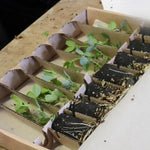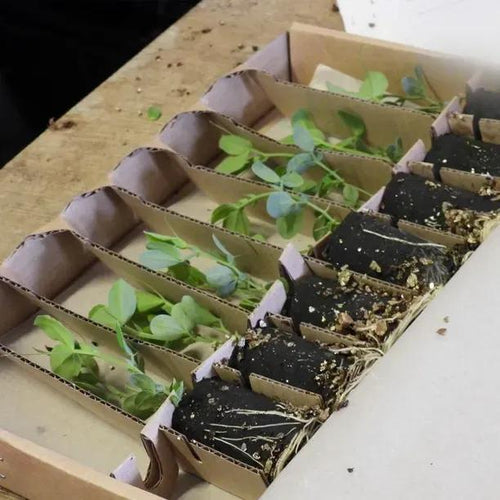Charlies Angel Sweet Pea Plants
'Charlies Angel' is a strongly scented annual sweet pea that was voted by BBC Gardeners World magazine in 2011 as the 'best ever sweet pea'. Its flowers have wavy petals in a heavenly shade of pale watercolour blue that fades to almost white at the edges. This classic modern grandiflora sweet pea has a place in every garden, clambering up over a wigwam of canes, over an obelisk or twining itself through arches and trellis, where its rich scent will perfume your garden. Its strong, long stems on a plant that grows to around 2m high mean it's the perfect specimen for cutting and bringing indoors to bring colour and scent to your home.
A hugely popular addition to our range of sweet pea seedlings.
Our Sweet Peas are delivered in purpose-designed, recycled cardboard packaging, and are ready to be planted out when you get them.
We generally send them out between March and May, but we will email you with the likely delivery timescale once you have placed your order.
Features
- Colour: pale lavender/watercolour blue with white edges
- Stem: long and strong
- Height: 2m
- Type: Spencer
- Scent: strong and heady
- Flowering: June to September
- Planting Months: March-June
- RHS Award of Garden Merit
Growing
Try growing a celestial scented combination with other subtly coloured sweet peas such as Anniversary or Gwendoline, with which it partners very well – always, always in a sunny spot and up an obelisk, trellis or pergola, in a pot or a border, where it'll wind its delicate tendrils quite happily, given a little encouragement early in its growth. Or plant it side by side with a perfumed pale pink rose. Charlies Angel's pale lavender charms would set off the pink a treat and create a dreamy pastel-hued show. Either way, keep your sweet peas well watered. This particular sweet pea has long, sturdy stems, so it lasts well indoors in a vase. Other varieties are good for cutting too, among them pale, almost coral pink Heaven Scent and bicoloured pink and white Promise. And don't forget that, as with all sweet peas, the more you pick, the more flowers the plant will produce, so don't be afraid to fill your vases to bursting!

 Secure, One-Tap Checkout
Secure, One-Tap Checkout
 Hand Picked, Delivered to Your Door!
Hand Picked, Delivered to Your Door! 1 Year Bareroot Guarantee
1 Year Bareroot Guarantee




